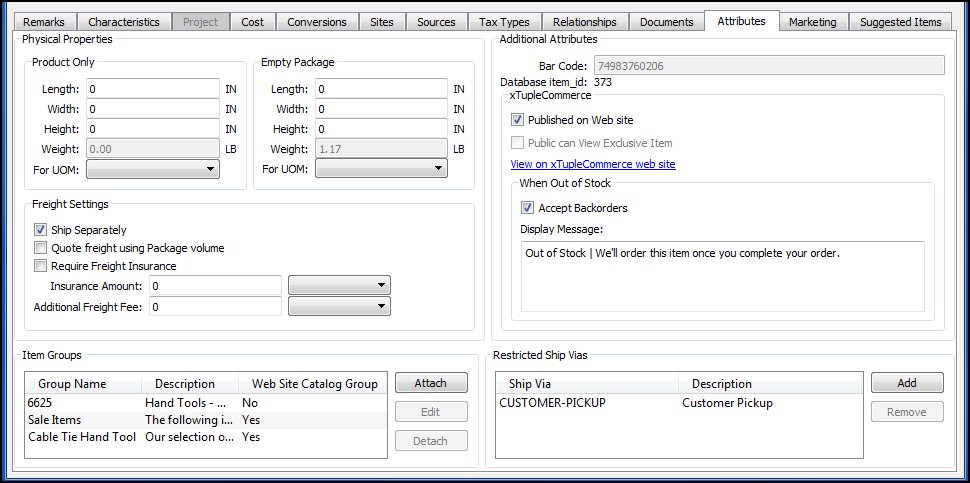
|
xTupleCommerce Product Guide |
The tab addresses the physical dimensions of the product, other static information about the product, and visibility of the product on the portal. All of the attribute information, with the exception of the item_id tag, can be imported or entered manually and then managed from the tab. (The item_id is auto-generated by the ERP.) Not all of the attribute information is displayed on the portal. However, the information is required for various xTupleCommerce features to function properly.
Here's a screenshot of the tab:

Attributes tab on Item screen
As you can see, the tab includes the following properties:
Physical properties are used to estimate the shipping/freight charges for items you sell online. By entering the weight of one unit of the product, the system will calculate the weight of the quantity ordered, send that information to the shipping services (UPS and/or FedEx), and receive an estimated cost for shipping. It's important to note that UPS and FedEx limit the weight and size of an individual shipment. For example, FedEx and UPS have a shipping limit of 150 lbs. If the total weight of the products ordered weighs over 150 lbs, this will require the shipment to be broken into multiple shipments. There are two different kinds of physical properties:
Product attributes include the length, width, height, and weight of the product as it is sold. The portal selling unit of measure (UOM) is needed for freight calculations. In most instances, the measurements are based on a single unit of product. However, you may have items whose measurements represent larger units (e.g., cases, sets, etc.). Product weight is derived from the Item master header.
Package attributes refer to the physical properties of the product packaging. This information should include only the shipping materials―not the product itself. As the quantity of the product increases in the customer's sales order, the weight of the shipping materials will also increase. Together, this information helps best estimate the shipping/freight charges. Packaging weight is derived from the Item master header.
Specify the following freight settings:
Select if the item must be shipped on its own, separate from (i.e., not packed with) other items.
Select if you want freight for the item to be quoted based on package volume.
Select if you want freight insurance to be required.
Enter the amount of insurance, specifying whether the amount represents a percentage of the order total, a flat rate, or a per-quantity rate.
Enter the amount of any additional freight fee, specifying whether the amount represents a percentage of the order total, a flat rate, or a per-quantity rate.
If an item belongs to one or more item group(s), these will be listed here. You can see the group name, description, and if that group is part of the web product catalog group. You can also attach the item to an existing item group, edit which item group it is in, and remove it from a particular item group. For more information about setting up the product catalog and item groups, see Section 3, “The Product Catalog”.
The following additional product attributes are available:
The bar code is the numerical code associated with the scannable bar code on the individual product. The bar code information displayed here is derived from the Item master header.
The database item_id is automatically generated by the ERP when you create a new item. This system-generated identifier is unique and cannot be changed. The item_id is not visible to end users, but may be viewed by web portal managers and administrators. It can also be useful to anyone querying information at the table level.
If you want the product to be displayed on the xTupleCommerce portal, this box must be checked. Once you select this option and save the record, a click-able link will be shown here. You can click on the link to view the product on the web portal. Or you can navigate to the Products page of your xTupleCommerce portal and find the product that way. If the product does not automatically appear, flush the cache. For more information on how to flush the cache, please see Chapter 1, Preparing the ERP for xTupleCommerce.
If selected, the product will be visible online to all users. However, the item may only be purchased by customers who are included in the exclusive item's pricing schedule(s). If not selected, exclusive items will be hidden from the general public. To learn more about how exclusive items are defined and scheduled, please see the video Selling Exclusive Items on xTupleUniversity.
Click on this link to view the online product page for the item.
Specify the desired web portal behavior when sold items are out of stock. For additional information, please see Section 2.7, “Out of Stock”.
Select if you want to allow customers to place orders even if the product is out of stock.
The message is displayed to customers if backorders are allowed and the product is currently out of stock. You can include two fields of information by using the pipe symbol () on your keyboard to separate the two parts of the message. For additional information, please see Section 2.7, “Out of Stock”.
If the item has a restriction on which ship via(s) (i.e., carriers) can be used, add that ship via to this list. If the item does not have any restrictions on ship vias, then leave this blank.